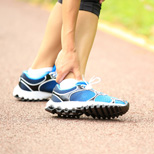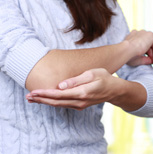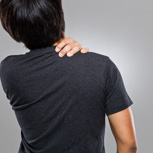INJURY BY BODY PART
ANKLE
Achilles Tendinitis
Background
The ankle is made of two joints. These joints need to be strong because they support the weight of the entire body. The ankle is one of the most versatile joint complexes in the body. It is built for weight bearing, mobility, adaptability and stability. The foot and ankle allow us to walk, stand, run and jump, and serve as our connection to the ground. The ankle must be able to withstand the stress of our body weight, and also be able to adapt to, and react quickly to, changes in environment and walking surface. Tendons are connective tissues that attach muscle to bone. They are strong, fibrous structures that are responsible for transferring the forces generated by the muscle to the bone, thus producing movement at the joint. When a tendon becomes irritated or inflamed it becomes painful, especially with movement. Inflammation of the tendon is called tendinitis.
Tendinitis
Tendinitis in the ankle occurs when the tendons that attach muscles to the bones in the ankle joints become inflamed. The tendons in the ankle include: The peroneals (peroneus brevis, peroneus longus), anterior tibialis, posterior tibialis, and Achilles tendon. Any of these structures can experience inflammation and subsequent pain.
Achilles Tendinitis
The Achilles tendon is the largest tendon in the body. It runs from the calf muscles to the heel bone. The Achilles tendon plays a significant role in the ability to walk, run, and jump. Because the Achilles tendon is used for activities that can put great stress on the tendon, it can be prone to the inflammation resulting in Achilles tendinitis. Pain from Achilles tendinitis commonly occurs along the back of the leg and in the vicinity of the heel and back of the foot. Individuals will experience pain, swelling and possible weakness of the tendon. Pain may be present first thing in the morning, after sitting, with running, jumping and any activities involving pushing off with the foot.
There are two different types of Achilles tendinitis based on where the inflammation occurs along the tendon.
- Non-insertional Achilles Tendinitis: This condition occurs when the fibers in the middle of the tendon begin to break down with tiny tears, causing swelling and thickening
- Insertional Achilles Tendinitis: This condition occurs in the lower area of the heel, where the Achilles tendon attaches to the heel bone. Bone spurs are a common complication of Insertional Achilles Tendinitis
Causes
Tendinitis is most often caused by an overuse repetitive strain injury (RSI).
Other high risk activities or conditions that can lead to the development of ankle tendinitis include:
- Participating in athletic activities that can strain the ankle and foot, like soccer or running.
- Repetitive strain injuries (RSI) at work occur in people who have jobs that require performing activities of a repetitive or forceful nature, like walking up and down stairs.
- Sudden trauma or an accident, like a fall where an individual lands hard on their ankle.
- Patients with rheumatoid or osteoarthritis may be susceptible to tendinitis
- Sudden increase in the amount or intensity of exercise like a change in the training regiment
Signs & Symptoms
- Ankle pain or tenderness directly over the tendon that can radiate to the foot or lower leg
- Pain or burning sensation during activities
- Difficulty performing activities of daily living
- Weakness may occur as the inflammation gets worse
- Feeling of tightness or loss of motion due to discomfort
- Swelling of the tendon
- Loss of motion at the ankle
Treatment
If an individual suspects they have tendinitis, the initial treatment should consist of avoiding the positions and activities that produce the pain. A course of conservative treatment is usually recommended that would include rest and immobilization, possible splinting, ice, physical therapy and non-steroidal medications to reduce inflammation.
If symptoms persist, treatment by your physician may be necessary. This may include steroidal medication or injections, in conjunction with therapy. In severe cases surgical intervention may be needed to correct any mechanical causes of the tendon irritation. It is also possible to rupture the Achilles tendon, which is a severe injury that will likely require a surgical repair.
Physical Therapy Interventions
Physical Therapists are professionals, educated and trained to administer interventions. As stated in The Guide to Physical Therapist Practice, interventions are the skilled and purposeful use of physical therapy methods and techniques to produce changes consistent with the diagnosis, prognosis and goal of the patient or client.
Common interventions in the treatment of Achilles Tendinitis include:
- Manual Therapeutic Technique (MTT): hands on care including soft tissue massage, deep friction massage, manual stretching and joint mobilization by a physical therapist to regain mobility and range of motion of the ankle and tendon.
- Therapeutic Exercises (TE) including stretching and strengthening exercises to regain range of motion and strengthen the ankle and effected muscle.
- Neuromuscular Reeducation (NMR) to restore stability, retrain the lower extremity, and improve movement technique and mechanics (for example, running, jumping, kicking, or stepping) in daily use of the involved lower extremity.
- Modalities that can include the use of ultrasound, electrical stimulation, ice, cold laser and others to decrease pain and inflammation at the ankle and tendon.
- Home program that includes strengthening, stretching and stabilization exercises and instructions to help the person perform daily tasks and advance to the next functional level.
Medical Interventions
Procedures that your physician may recommend and perform in addition to physical therapy may include:
- Rest and ice
- The use of NSAIDS (Non Steroidal Anti-Inflammatory Drugs)
- Steroidal injections to reduce inflammation
- Pain medication to reduce the discomfort and allow the patient to perform the recommended exercises
- Surgery to correct underlying pathology or the cause of the tendinitis
- Splinting to rest or immobilize the ankle and effected tendons
Prognosis
Most people recover full function following a course of conservative care that includes physical therapy, medication and/or injections. It is important that once the pain and inflammation is reduced, and motion and strength are restored, the patient gradually returns to full activities. Instruction in daily activities or sport performance is helpful for reducing a reoccurrence of tendinitis.
Prevention
It is easier to prevent tendinitis than to treat it.
Below are some tips to reduce the risk of tendinitis.
- Warm up lightly before activity to improve circulation and lubricate the muscle and tendon. Warm up should be performed to the area that will be used.
- Stretch the tendons and muscles you will be using after your warm up, prior to the activity and after it. Do not bounce when stretching. Instead, hold the stretch for 15-20 seconds.
- Strengthen the muscles and tendons that you need to use for your activity. A regular strengthening program three times a week will keep muscles prepared for the job you are asking them to perform.
- Do not work through pain. Listen to your body. Avoid the “no pain, no gain” philosophy.
- Kendall Park
- Edison
- Princeton
- Old Bridge
- Monroe





















